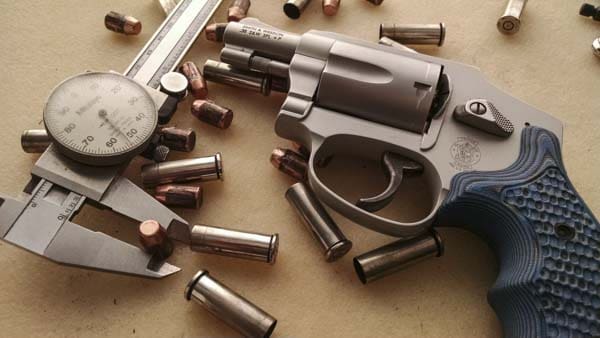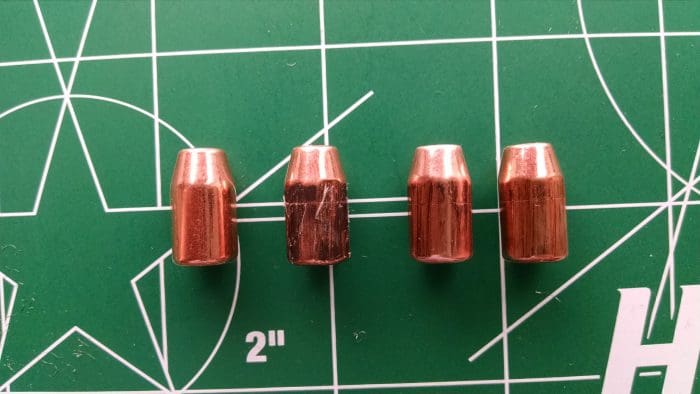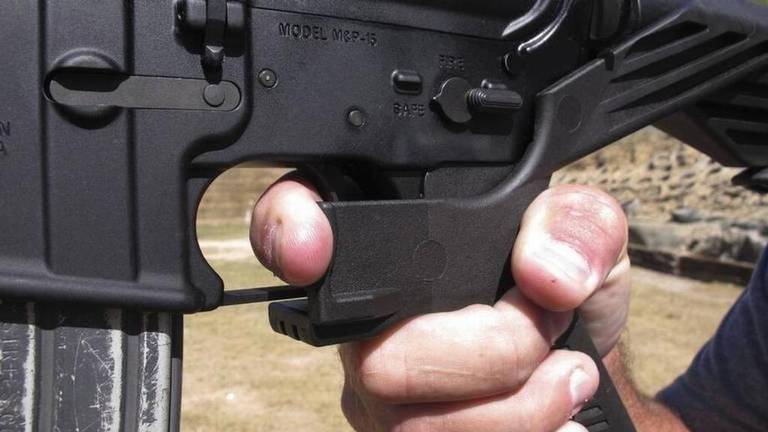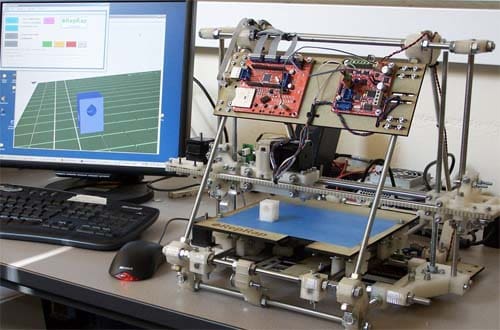
It seems I can’t walk out my door these days without getting into some sort of nonsense argument over bullets or cartridges. Granted, I do start some of those arguments, but the latest one was more of a conversation about movies. Long story short, I got into a conversation with a guy at my local big-box gun store while out shopping.
The back-and-forth started like usual while I browsed the reloading component section for some .38 caliber plated lead bullets. I found my box of Berry’s and elbowed my way past said guy who smiled and said something to the effect of “too bad you can’t use them over again” while complaining about the price of his favorite brand of lead.
I agreed and then made a fatal error; I stopping to check out the price on another box. The guy took this as my decicion to stay and engage in a half hour of small-talk while I tried desperately to get away to the ever-longer checkout line. Despite my best efforts, he ended up in line behind me and so began an agonizing lesson in talking to strangers.
The guy asked me if I watched The Walking Dead, and I admitted I did. Now, I’m a fan of Rick and the rest of the crew, but I have wondered how he seems to have a never ending supply of .357 for that Python of his. Plot armor and complete ineptitude aside, Rick and his troupe never seem to be in short supply of bullets and are constantly able to make expert-level headshots with every pull of the trigger.
I’d barely made it to the candy by the checkout counter when we arrived at the point in conversation when he alleged that Rick could actually make pistol reloads with a simple hand press, a box of primers, and a pound of powder. Sure, he certainly could. The guy in line then said something interesting. He thought that Rick and crew actually reused the bullets, not just the brass.
I puzzled over that and agreed it was possible, but only in a world where ratings mattered more than logic. I managed to check out and made for my car, put it into sport mode, and floored it.
My wife loves to hear stories about what people in gun stores say. She finds most of gun culture to be completely absurd and actively calls out people that step over the ‘commando’ line whenever we shoot or hunt. Her amount of knowledge and subsequent ability to poke fun at the community makes her a deadly buzzkill at most competitions or gun counters. I told her about my adventure and she mulled the numbers for a moment. Seeing no immediate holes in the logic, she suggested we catch some bullets just for the sake of it.
Neither of us looked online or talked to anyone about it. I was determined to be unbiased in my evaluation because, you know, science. Or something.
For this test I elected to go with a gun I knew would be able to handle the task. My Smith & Wesson 642 always comes in handy and this time was no different. I loaded up the pistol, still equipped with fantastic Hogue Piranha grips, and let fly. The 158gr plated lead bullets were powered with some Trail Boss powder and were fired into a makeshift bullet trap about ten feet away. I measured the diameters of each of the test bullets and found them all to be a very uniform .358 inches, just as advertised on the box.

Velocity with was measured at a moderate 775 fps from the 642’s short barrel. I find that Trail Boss gives very consistent velocity, but really maxes out most cartridges at under 1000fps as you can’t compress the powder safely.
I was happy with the results and recovered my trapped bullets. They were mostly undamaged and appeared that they could be loaded up and fired again. I took the bullets home and measured them, recording a range of diameters. All bullets measured between .350” and .355” with the average being .353”. It must be noted that some bullets were slightly deformed, but these were weeded out.
This is the part of the story where I reassure you that I’m a professional and a seasoned reloader. I took the fired bullets and sorted them at .353”, polished them with a bit of steel wool, and proceeded to load them. Now comes the part where I mention that I don’t recommend that you try this little stunt at home.
The wife and I took the zombie loads and proceeded to fire them again. What happened was pretty remarkable.
Not only was there almost no change in velocity, but there was hardly anything different at all. Velocity averaged a slightly higher 800 fps and accuracy was unchanged. I had honestly thought that there would’ve been a far greater difference in performance. Something about this whole thing just didn’t seem quite right so I went ahead and loaded and fired an additional handful of pre-fired bullets. Same results.
Since I’m not one to be easily defeated, I took the twice-fired bullets and loaded those up again. Like the first (well, second) time they averaged .353”. I fired the twice-fired bullets and came up with identical results as the earlier firings.
There has to be a maximum number of times a bullet could be fired before it isn’t able to function like normal, but I haven’t found that number yet. I have in my possession three bullets that have been loaded and fired a whopping ten times. The rifling marks appear to be ‘overwritten’, but have smoothed out somewhat. The bullets could probably be loaded and fired another ten times based on their good condition.

I’m pretty confident that since the plated bullets have lost no weight and have only ‘slimmed’ by an average of .005 over ten firings, they’re perfectly capable of being used over and over. The only game-over moment comes when a bullet gets damaged or mashed beyond use. I have not had a chance to test this theory in a semi-auto pistol yet, but I intend to at least try it in the future. My concern with that would be the thinner bullets would cause malfunctions in the cycling process.
My takeaway from this made me realize that in some cases, the bullets can be used over again, thus validating the random chatty stranger and his assertions about a TV show that has gone on about two seasons too long. Now, how Rick manages to get the bullets out of the zombies or off the ground behind them reliably is another story for another day, but the concept is sound.




“The only game-over moment comes when a bullet gets damaged or mashed beyond use. “
There’s the rub.
You said you hunt. Have you EVER recovered a bullet used to kill an animal…that hit bone for example (do Zombies on that show require headshots? I’ve never seen one single episode)…that was NOT deformed?
Also, I didn’t see where you said what range you tested accuracy. Here’s my problem with this idea as a general idea: throwing off the balance/weight distribution of the bullet. May not matter for SHORT range handgun use, but I’d bet dollars to donuts you’d see an accuracy effect out at 50 yd or longer.
You said the bullet trap was 10 ft away. Was that the range of the accuracy test, too? If so, who tests “accuracy” at 3.3 yards and calls it “the same.” No seasoned reloader I’ve ever met would do that.
Dollars to donuts? I’d go Zimbabwe dollars to US dollars. Even if it’s a boat-tail that is stopped by water, something is going to be twisted, bent, deformed, whatever just from rapid deacceleration. Especially by the third time around, let alone the tenth. Will it be enough to matter at essentially point-blank, crawling out of a snubby? Meh.
Will it matter 50-100+ yards out? Of course it will. Especially out of a gun with some barrel length, capable of generating some actual velocity.
Is there a very limited set of projectiles, guns, distances, and backstops where one could pull this off at short range? Sure, why not? Would I try to hit anything even a mere 100M out with one? No thanks.
“Even if it’s a boat-tail that is stopped by water, something is going to be twisted, bent, deformed, whatever just from rapid deacceleration.”
My point exactly. Thanks for stating it more clearly than I did.
“Even if it’s a boat-tail that is stopped by water, something is going to be twisted, bent, deformed, whatever just from rapid deacceleration.”
I’m with you on that.
I’d be concerned with what stresses *slightly* out-of-round projectiles may induce on the barrel of the gun. Out-of round means likely higher barrel pressures until the round is fire-formed round enough to exit the barrel.
As a result of this article, word will get out, and I can foresee ‘preppers’ scavenging lead at ranges with sand backstops and saving up 5-gallon pails of the stuff with un-known consequences *years* down the line.
The only rounds I have routinely re-used were those yellow E.A.R. foam earplugs I reloaded wadcutter-style flush with the brass being driven primer ONLY for shooting flies on my back porch with Super Redhawk .44 mag…
I don’t know if that’s evil genius or just lazy. Either way, that’s a hell of a fly swatter.
I’ve shot a lot with sand backstops, and I would NOT want to re-use any of the bullets for anything where I was depending on the accuracy of the shot!
“Out-of round means likely higher barrel pressures “
Excellent point, as evidence by his observed increase in velocities. Average of 25 fps may not be all that much, but quite possibly “real” (he didn’t publish SD or spread in velocity, so can’t assess if a statistically real increase or not).
It takes a desperate man to shoot out-of-round or otherwise deformed bullets…especially when there are many other options available.
A surprisingly flat-shooter at back-porch ranges, JWM. And surprisingly quiet, just a moderate ‘pop’ sound.
I’d love it if someone tries it with .38 or .357 and reports their experience with it.
The key seemed to be cylindrical plugs flush with the mouth of the brass…
Dude my Dad used to work with would melt wax in a pan to about 1/8″ or so in depth, then let it harden.
He took .38 Spl primed cases (no powder of course) and just pushed down on the wax (using the case like biscuit cutter sorta) and seated the resulting wax plug in the case mouth.
Made excellent indoor practice ammo…for trigger time, at least.
JR, that was a common enough practice in my youth. Household basement ranges were not unheard of in the parts of the country that actually got winter. Our favorite targets for squib loads and pellet pistols were playing cards.
A deck of cards. Masking tape. An old carpet or two. A cardboard appliance box and you had a pretty decent winter house range.
I don’t think the bullets would be the limiting factor as you can get lead to cast from many sources. Like wise with powder if you know the chemistry, I’ve seen guys shoot black powder in .357 because the case is so long. The tough part is going to be primers. Maybe Eugene is making them from match heads?
If you are willing to live with some safety concerns (and I already concern even normal primers the most dangerous component to handle), one can formulate priming compounds with little more knowledge of chemistry than it takes to make the powder.
I’ve heard of people that reload primers; a friend of mine may have done it (I’m trying to recall if he said he did). They remove the anvil, punch the firing pin dimple out of the cup, add the primary and reinsert the anvil.
It’s quite labor intensive, but it can be done.
Here’s a primer on reloading primers: https://www.youtube.com/watch?v=t_7LWCFH5Gc
Also, 0.005″ is a pretty large variance for diameter. Did you sort those bullets into 0.001″ ‘bins’ to load as ordered groups?
I just can’t imagine, based on my experience with load development, that a 0.005″ diameter range would be ‘just as accurate’ no matter what the “average” was.
Average means little-to-nothing; it’s the absolute variance that matters much more.
Notice the QC on the bullets straight out of the box was within 0.001″. There’s a reason for that.
cool article, thanks. i dont reload, but i always kind of wondered this after finding fired bullets in sand piles. i probably still wouldnt try it, though.
I’ve seen any number of fired bullets at the ranges that look to be good enough to reuse to the naked eye. I’ve never done a study on the project but just from casual observation. With one exception the bullets are always fmj’s. That one exception has been low velocity .38 wadcutters. To the naked eye they look good unless they hit something like a rock or a target support.
Very interesting. Unfortunately, the range I’m a member of has gravel for its back stop. I’ve always wondered if one could do that.
The reloading components aisle in Cabelas is quite possible one of the most interesting, and yet terrifying at the same time, cross sections of the shooting community that can be found in one single place. I sometimes go even when I don’t need anything to just pick up boxes to look at all while listening over my shoulder.
I wonder if your findings are unique to plated bullets, I used to have a metric ton of blazer brass in 40s&w and on one occasion was shooting at clay pigeons I had laid up against a brush pile at the ranch. Upon walking around the pile after the shooting was over I came across dozens of the fired bullets in nearly perfect condition (barrel had polygonal rifling). It never occurred to be to reload them, but it was pretty interesting that aside from powder burns and some scuffin on the bearing surface they looked nearly untouched.
‘…people that step over the ‘commando’ line…’
I like it. The first step to becoming an ‘operator’.
Wasn’t the plot line of the movie “shooter” driven by a “paper wrapped bullet” that could be recovered and re-used/shot through a second rifle to frame someone of a crime?
I saw it in a movie so it has to be true.
Yea, the part about that the movie didn’t explain is that most paper-patched bullets are lead.
ie, they’re not the low-Bc type of pill you could use to make the shot in the movie…
Well, this was a bit of a surprise, but I’d assume most jacketed bullets would not be reloadable due to deformation unless they are only shot through paper into a trap.
The only bullets I consider reusable are cast lead since they can be recast, but you will still lose material if you shoot steel targets.
Well, if you’re not wed to jacketed bullets, you could shoot lead, and even if the bullet is mangled, you just melt it down, and re-cast it as a perfectly usable bullet.
Lead recycles really well, and at a low cost. For loads that are pushing sub-sonic bullets, it works quite well.
I’ve had the same bits of lead kill many an animal, recycled in my 44s, 45s, and 50s.
I was thinking the same thing. Not that I’ve done any such thing; I’ve only recently taken my first foray into reloading with a Lee Loader, once fired .45 Colt brass, 250 gr lead pre-lubed RNFP bullets, and Pyrodex. I can’t wait to try them out. At this point, I’m a bit leery of lead pots.
” I’m a bit leery of lead pots.”
It’s not too bad, use leather gloves, do it outdoors and stay upwind (I used the fume hoods at work for my melting) and wash up *thoroughly* afterwards.
OK. This explains a lot. 🙂
Theoretically, couldn’t you just run the lead round through the resizer, relube it, and be ready to load it? The sizing die for the cast bullet should, in theory, make the bullet round again. Might work for a wadcutter style bullet anyway.
Precisely what I was going to say. I don’t see why it wouldn’t work on a plated bullet. I imagine it would also work on a jacketed bullet but you might need lots of extra grunt to force it through the sizer.
Huh. Also one could swage them down or squash (I mean like bucking a rivet) them to adjust the diameter. Though I’ve no idea how much if any of that a jacket would take.
My backstop is a drum full of shredded-tire mulch. Last year it more often than not gave me back .38 caliber commercial “hard cast” 158 grain SWC bullets that could be fired again. Just run ’em through the lubrisizer and load ’em up. I never even thought that this was particularly remarkable.
I’ve long ago forgotten which tale of the colonial frontier had the story of the Indian who possessed a smoothbore muzzleloader, and used the same bullet over and over, pounding it back to shape on a rock if it got deformed.
What did you use for the bullet stop to preserve the bullets?
(“Possible … But not recommended!!)
I had an old, original 11.3mm Beaumont-Vitali bolt action rifle. The rifling was badly worn, so accuracy wasn’t of primary concern. I reloaded brass from a box of (expensive!) new cartridges. I used lead cast “range pick-ups” in .45 ACP and a modern black powder substitute, loaded for low pressure. Worked ’em up with a drill press I did. Measured each one with calipers for proper overall length.
They all went bang, and flew as well as could be expected from a rehabbed beater of a 140 year old gun. Picked a flea off’n a woodchuck’s ear at 900 yards or so. (OK, that last part may be a stretch …) (But! …They did beat a smooth-bore musket!)
Comments are closed.